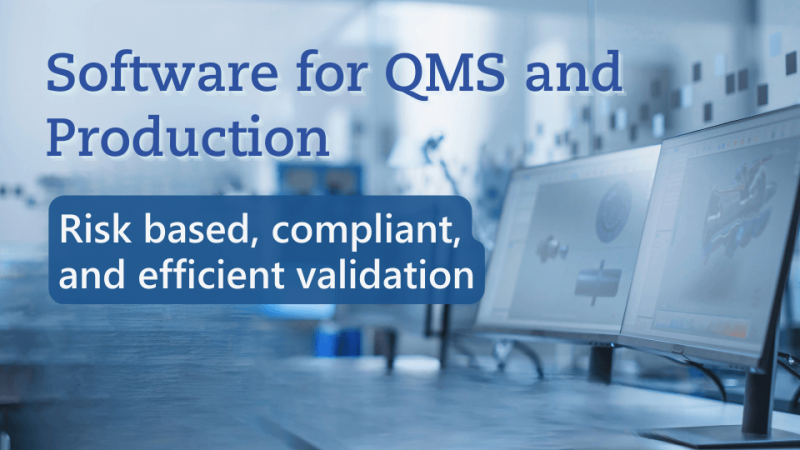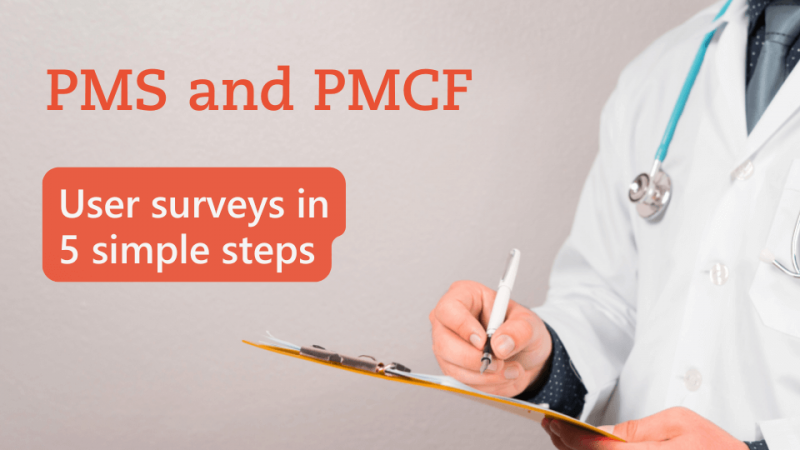V&V Finally Clearly Defined – And how coffee helps us understand it
15/02/2022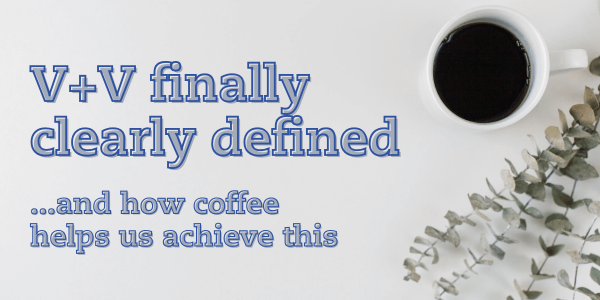
Do you have any questions about the article or would you like to find out more about our services? We look forward to hearing from you!Make a non-binding enquiry now
As promised, in our 2022 articles, We will show you how to finally reap the maximum benefits from Verification and Validation by leveraging them to achieve your business goals. Today, we'll establish a shared understanding as the foundation for future discussions: What do Verification and Validation mean? And why is it often challenging to clearly distinguish between the two terms?
To set the stage, let's begin with a brief recap from the article V+V - Quick Tips 2022:
Verification and Validation (V&V) are among the most crucial in quality management and assurance tools. Quality here refers to the degree to which requirements—be they guidelines, expectations, or agreements, both external and internal—are met.So, what significance do Verification and Validation hold for you as a medical device manufacturer? Let's examine how frequently these terms appear in key regulatory documents: The more often a term is mentioned, the more important it is, providing insights into the areas these regulations emphasize.
Frequency of Terms in Key Regulatory Documents
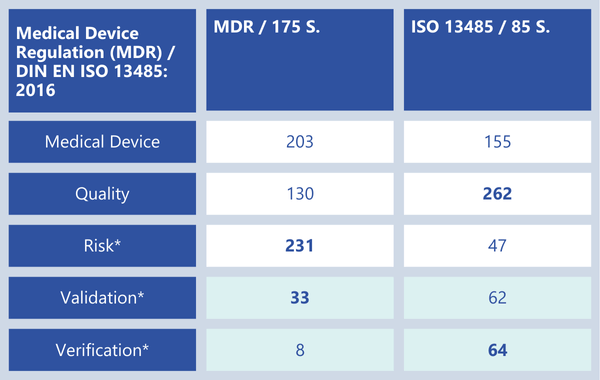
Table 1: Frequency of Terms
Given the "New Approach," it's no surprise that the Medical Device Regulation (EU) 2017/745 focuses heavily on risk management. Similarly, quality is the primary focus of the standard for quality management systems (DIN EN ISO 13485:2016). Both documents also place significant emphasis on the validation of medical devices, with DIN EN ISO 13485:2016 particularly stressing verification.In summary, Verification and Validation (V&V) are mentioned 167 times in total. This makes it clear that V&V are deeply embedded in the regulatory and normative requirements of the medical device industry. Without thoroughly addressing each mention, it's impossible to produce documentation that meets EU certification or approval standards. A first step towards such documentation is a systematic review of all references to V&V, to develop optimal solutions or strategies.Before delving deeper into potential solutions in my next article, it is crucial to establish a common understanding of the methods of Verification and Validation. So, let's first define what it means to verify and validate. After all, these are actions that must be performed to achieve a satisfactory outcome.
The verb "to verify" comes from the two Latin words verus (true, correct) and facere (to make); in Italian, verificare also means "to check."At Metecon, we interpret "verification" as follows: to demonstrate through testing and documentation that a given situation meets the agreed-upon requirements. ISO 9001:2015 defines verification as "confirmation, through the provision of objective evidence, that specified requirements have been fulfilled."Verification refers to the process of verifying, which usually refers to all verifications associated with a product, including a final confirmation.
In Italian, which is still closely aligned with its Latin roots, there is no distinction between verification and validation—both are referred to as verifica.Additional precise definitions include:
The tasks involved in verification are checking and documenting, possibly including recording data. For instance, if the specified requirement is:"A robot should have the degree of freedom to rotate around its axis,",a test can determine whether this requirement is met. However, to prove compliance, objective evidence is needed. This could be a test protocol detailed enough to ensure that the test can be repeated with the same result. A test protocol, or an inspection protocol during inspections, is necessary as objective evidence for every requirement.Many requirements are set out in standards, which often also specify the tests and inspections needed to verify these requirements. If a product passes all tests against a standard and the tests and inspections are documented, the product can be said to be verified against the standard.
No! If there are no clear acceptance criteria for a requirement, it cannot be verified, as it is unclear how the requirement can be definitively met. This is the case in our example above—what exactly does "rotation around its axis" mean? It may lack a drawing or specific acceptance criteria, such as "rotation by +/- 361° with an accuracy of +/- 0.5°" or "free rotation without limitation in both directions."Some requirements are fundamentally unverifiable because current technology does not allow it:Example from medical technology:
Is a product sterile in its packaging?
Solution: Validation of a sterilization process.Example from a laboratory:
Is the transformer potted in a way that leaves no air pockets?
Solution: Validation of a vacuum potting process.Here, it becomes clear that validation is applied when verification is not possible.Verification can also fail:
What should be done if the robot cannot rotate around its axis?
Correct: The specification has not been met, and there is no approval for the design result.
Incorrect: The requirement to rotate around the axis is removed. :-)
The verb "to validate" is derived from the Latin valere, meaning "to be worth, to have value"; in Italian, convalidare means "to declare valid, to authenticate," and valevole means "valid."At Metecon, we interpret "validation" as follows: to declare a given situation valid, based on justified reasoning, so that it is accepted by third parties. ISO 9001:2015 defines validation as:
"Confirmation, through the provision of objective evidence, that the requirements for a specific intended use or application have been fulfilled."
Here, we must discuss the definition of validation in ISO 9001:2015. Why? Because the definition of validation is unfortunately poorly chosen and, in practice, tends to cause confusion rather than clarification. Let’s examine this by comparing the definitions of verification and validation, keeping in mind that ISO 9001 is not the management system standard for medical devices. Unfortunately, ISO 13485 for medical device manufacturers does not provide definitions here.As we see in the following table, ISO 9001:2015 attempted to structure the definitions of verification and validation similarly. Unfortunately, by aligning the definitions under the term "confirmation," the true nature of validation has been lost, and validation is now presented as a type of verification. This suggests that the standards committee could not reach a consensus on the term validation.The etymology and meaning of the verbs "to verify" and "to validate" were completely overlooked here—resulting in even more confusion around the concept of validation. The definition of validation can now be interpreted either correctly or incorrectly.An incorrect interpretation of validation is to consider it a special form of verification. The correct interpretation of validation is a justified assessment of how well a situation meets a requirement.The definition of validation in ISO 9001:2015 sometimes leads to functional tests of a device being interpreted as the device's validation, even though it's unclear whether the user can achieve the intended purpose with the device.
Click on graphic for full size view
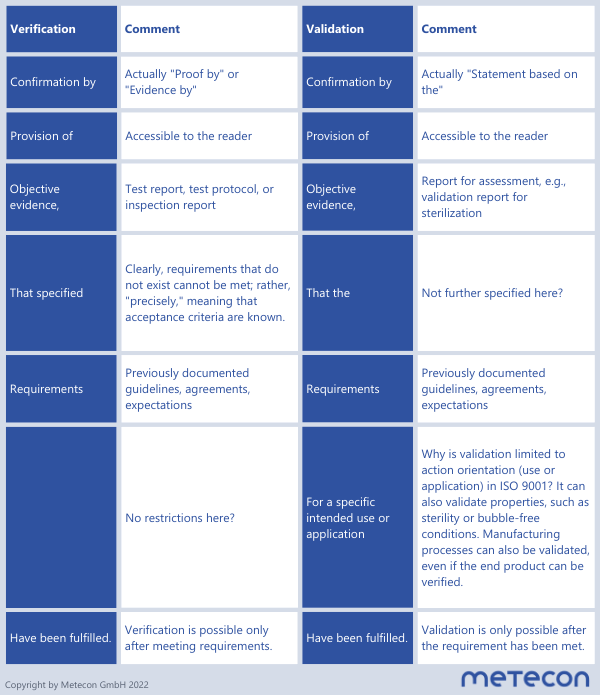
Table 2: Comparison of Definitions "Verification" vs. "Validation" according to ISO 9001:2015
Returning to the definition of validation, let’s consider the following requirement: "I want a coffee that tastes good."For coffee to taste good, it must first and foremost have a taste. This can be verified, as it is known which chemical substances are detected by taste receptors, and these substances can be identified through tests in the coffee. However, it is not known which combination of substances universally constitutes good-tasting coffee. Therefore, we cannot verify the statement "The coffee tastes good!" But can we still claim that the coffee tastes good and thereby fulfill the requirement "The coffee tastes good"? What needs to be done?This question leads directly to the answer: What must be done to convince the recipient of the coffee that it tastes good before they have personally tasted it?
The process requires analysis, testing, documentation, evaluation, and assessment. In essence, it must be validated.
During validation, objective evidence is gathered to support the evaluation and assessment, forming the basis for justification. Such evidence might include study results on taste perception or chemical analyses confirming that the ingredients are comparable to those of previously validated good-tasting coffee.A crucial aspect of validation is that third parties must be able to accept the validity of a statement. Therefore, it may be necessary to document the authority, role, competence, and experience of the person conducting the validation to achieve acceptance of the documented evaluation and assessment. After all, can just anyone sign off on an acceptable clinical evaluation?To validate means to:
We know from frequent feedback from our newer clients that the topic of verification and validation can raise many questions, especially when encountered for the first time.We hope that our quick tips on verification and validation offer you initial assistance in this area.If at any point in the process you are stuck, we will be happy to give you individual feedback on your specific questions.
To set the stage, let's begin with a brief recap from the article V+V - Quick Tips 2022:
Understanding the importance of verification and validation
Verification and Validation (V&V) are among the most crucial in quality management and assurance tools. Quality here refers to the degree to which requirements—be they guidelines, expectations, or agreements, both external and internal—are met.So, what significance do Verification and Validation hold for you as a medical device manufacturer? Let's examine how frequently these terms appear in key regulatory documents: The more often a term is mentioned, the more important it is, providing insights into the areas these regulations emphasize.
Frequency of Terms in Key Regulatory Documents

Table 1: Frequency of Terms
Given the "New Approach," it's no surprise that the Medical Device Regulation (EU) 2017/745 focuses heavily on risk management. Similarly, quality is the primary focus of the standard for quality management systems (DIN EN ISO 13485:2016). Both documents also place significant emphasis on the validation of medical devices, with DIN EN ISO 13485:2016 particularly stressing verification.In summary, Verification and Validation (V&V) are mentioned 167 times in total. This makes it clear that V&V are deeply embedded in the regulatory and normative requirements of the medical device industry. Without thoroughly addressing each mention, it's impossible to produce documentation that meets EU certification or approval standards. A first step towards such documentation is a systematic review of all references to V&V, to develop optimal solutions or strategies.Before delving deeper into potential solutions in my next article, it is crucial to establish a common understanding of the methods of Verification and Validation. So, let's first define what it means to verify and validate. After all, these are actions that must be performed to achieve a satisfactory outcome.
The definition of verification
The verb "to verify" comes from the two Latin words verus (true, correct) and facere (to make); in Italian, verificare also means "to check."At Metecon, we interpret "verification" as follows: to demonstrate through testing and documentation that a given situation meets the agreed-upon requirements. ISO 9001:2015 defines verification as "confirmation, through the provision of objective evidence, that specified requirements have been fulfilled."Verification refers to the process of verifying, which usually refers to all verifications associated with a product, including a final confirmation.
In Italian, which is still closely aligned with its Latin roots, there is no distinction between verification and validation—both are referred to as verifica.Additional precise definitions include:
- To Check: "to determine the extent to which a test object meets a requirement" (ISO 1319).
- Objective evidence: "data supporting the existence or truth of something" (ISO 9000:2015).
- Requirement: "a need or expectation that is stated, generally implied, or mandatory" (ISO 9000:2015).
An example of checking and documenting
The tasks involved in verification are checking and documenting, possibly including recording data. For instance, if the specified requirement is:"A robot should have the degree of freedom to rotate around its axis,",a test can determine whether this requirement is met. However, to prove compliance, objective evidence is needed. This could be a test protocol detailed enough to ensure that the test can be repeated with the same result. A test protocol, or an inspection protocol during inspections, is necessary as objective evidence for every requirement.Many requirements are set out in standards, which often also specify the tests and inspections needed to verify these requirements. If a product passes all tests against a standard and the tests and inspections are documented, the product can be said to be verified against the standard.
Can every requirement be verified?
No! If there are no clear acceptance criteria for a requirement, it cannot be verified, as it is unclear how the requirement can be definitively met. This is the case in our example above—what exactly does "rotation around its axis" mean? It may lack a drawing or specific acceptance criteria, such as "rotation by +/- 361° with an accuracy of +/- 0.5°" or "free rotation without limitation in both directions."Some requirements are fundamentally unverifiable because current technology does not allow it:Example from medical technology:
Is a product sterile in its packaging?
Solution: Validation of a sterilization process.Example from a laboratory:
Is the transformer potted in a way that leaves no air pockets?
Solution: Validation of a vacuum potting process.Here, it becomes clear that validation is applied when verification is not possible.Verification can also fail:
What should be done if the robot cannot rotate around its axis?
Correct: The specification has not been met, and there is no approval for the design result.
Incorrect: The requirement to rotate around the axis is removed. :-)
The definition of validation
The verb "to validate" is derived from the Latin valere, meaning "to be worth, to have value"; in Italian, convalidare means "to declare valid, to authenticate," and valevole means "valid."At Metecon, we interpret "validation" as follows: to declare a given situation valid, based on justified reasoning, so that it is accepted by third parties. ISO 9001:2015 defines validation as:
"Confirmation, through the provision of objective evidence, that the requirements for a specific intended use or application have been fulfilled."
Definition of validation according to ISO 9001:2015 – a source of confusion
Here, we must discuss the definition of validation in ISO 9001:2015. Why? Because the definition of validation is unfortunately poorly chosen and, in practice, tends to cause confusion rather than clarification. Let’s examine this by comparing the definitions of verification and validation, keeping in mind that ISO 9001 is not the management system standard for medical devices. Unfortunately, ISO 13485 for medical device manufacturers does not provide definitions here.As we see in the following table, ISO 9001:2015 attempted to structure the definitions of verification and validation similarly. Unfortunately, by aligning the definitions under the term "confirmation," the true nature of validation has been lost, and validation is now presented as a type of verification. This suggests that the standards committee could not reach a consensus on the term validation.The etymology and meaning of the verbs "to verify" and "to validate" were completely overlooked here—resulting in even more confusion around the concept of validation. The definition of validation can now be interpreted either correctly or incorrectly.An incorrect interpretation of validation is to consider it a special form of verification. The correct interpretation of validation is a justified assessment of how well a situation meets a requirement.The definition of validation in ISO 9001:2015 sometimes leads to functional tests of a device being interpreted as the device's validation, even though it's unclear whether the user can achieve the intended purpose with the device.
Click on graphic for full size view

Table 2: Comparison of Definitions "Verification" vs. "Validation" according to ISO 9001:2015
Validation: What must be done to meet the requirement?
Returning to the definition of validation, let’s consider the following requirement: "I want a coffee that tastes good."For coffee to taste good, it must first and foremost have a taste. This can be verified, as it is known which chemical substances are detected by taste receptors, and these substances can be identified through tests in the coffee. However, it is not known which combination of substances universally constitutes good-tasting coffee. Therefore, we cannot verify the statement "The coffee tastes good!" But can we still claim that the coffee tastes good and thereby fulfill the requirement "The coffee tastes good"? What needs to be done?This question leads directly to the answer: What must be done to convince the recipient of the coffee that it tastes good before they have personally tasted it?
The process requires analysis, testing, documentation, evaluation, and assessment. In essence, it must be validated.
During validation, objective evidence is gathered to support the evaluation and assessment, forming the basis for justification. Such evidence might include study results on taste perception or chemical analyses confirming that the ingredients are comparable to those of previously validated good-tasting coffee.A crucial aspect of validation is that third parties must be able to accept the validity of a statement. Therefore, it may be necessary to document the authority, role, competence, and experience of the person conducting the validation to achieve acceptance of the documented evaluation and assessment. After all, can just anyone sign off on an acceptable clinical evaluation?To validate means to:
- Gather objective evidence,
- Analyze and evaluate this evidence in relation to a specific matter,
- Assess and declare it valid based on proven competence and experience.
We know from frequent feedback from our newer clients that the topic of verification and validation can raise many questions, especially when encountered for the first time.We hope that our quick tips on verification and validation offer you initial assistance in this area.If at any point in the process you are stuck, we will be happy to give you individual feedback on your specific questions.
Our blog posts are researched and created with the utmost care, but are only snapshots of the regulations, which are constantly changing. We do not guarantee that older content is still current or meaningful. If you are not sure whether the article you have read on this page still corresponds to the current state of regulation, please contact us: we will quickly place your topic in the current context.

